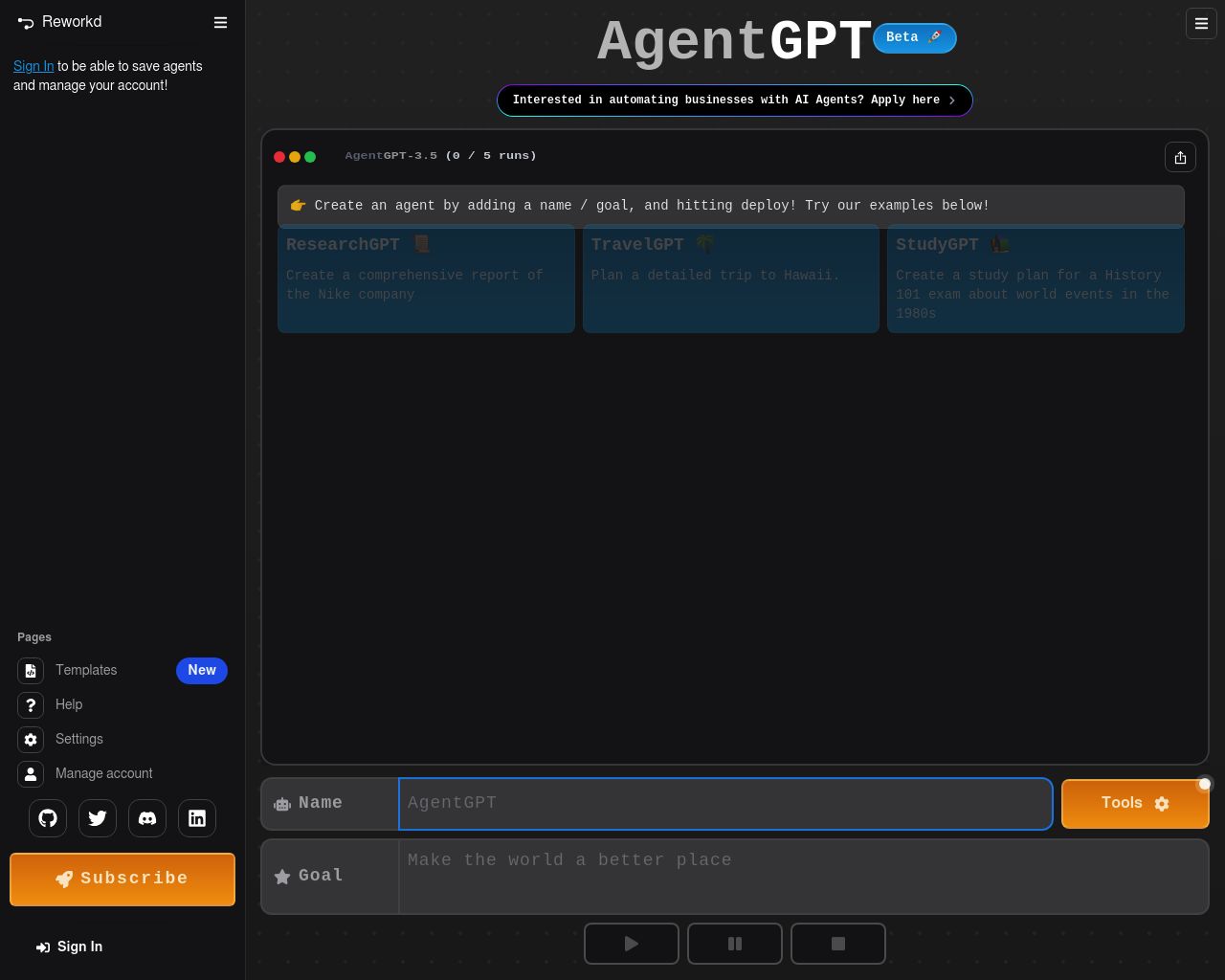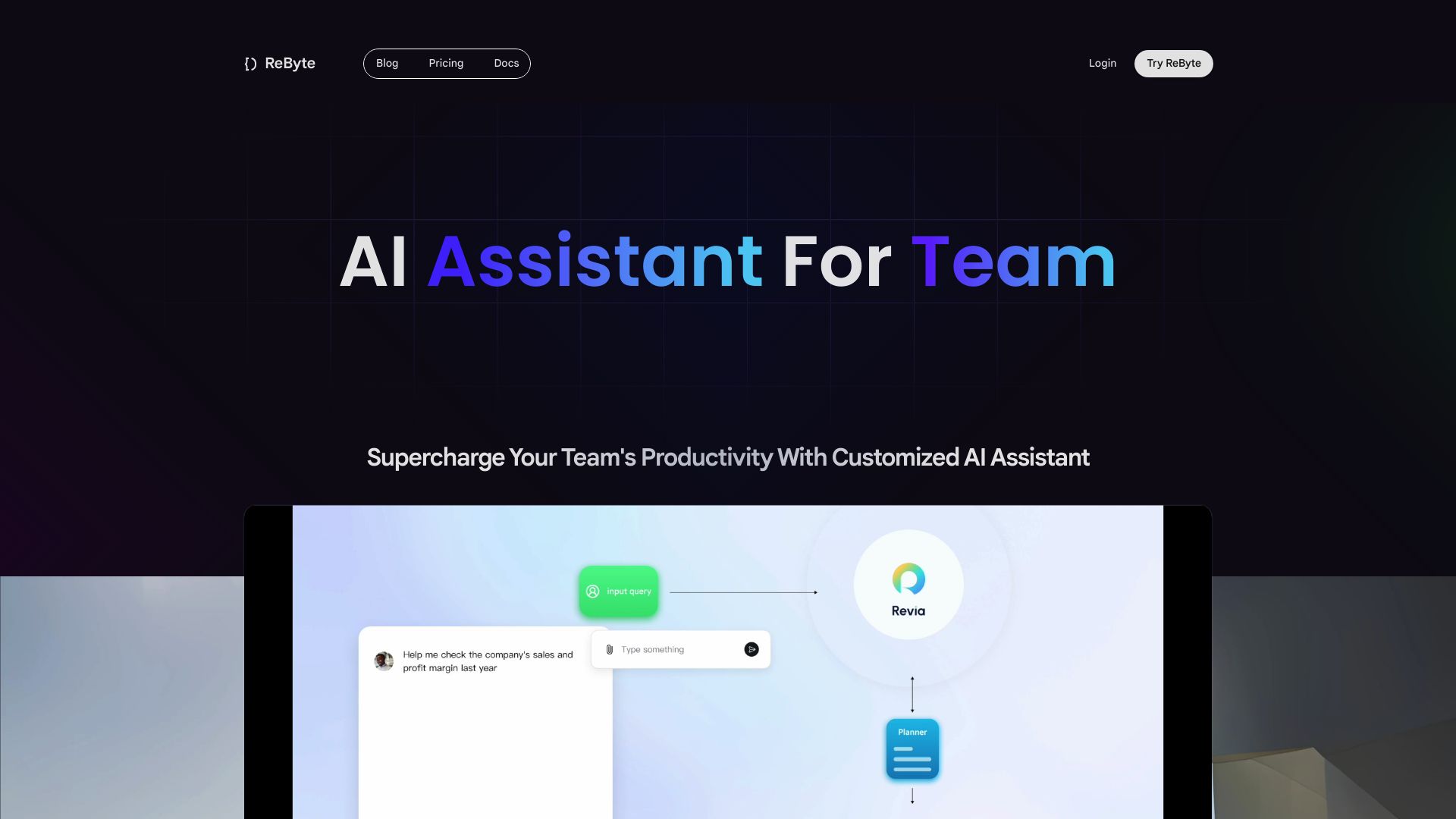AgentGPT vs. Rebyte: Comparing AI Agent Platforms
AI agent development platforms are revolutionizing how businesses and developers harness artificial intelligence. AgentGPT vs. Rebyte offer distinct approaches to this challenge, each with unique strengths and limitations. AgentGPT focuses on autonomous task execution and advanced memory management, while Rebyte emphasizes visual development tools and no-code accessibility. This comparison delves into the core features, development approaches, and real-world applications of both platforms.
We’ll explore how each addresses key concerns like scalability, security, and ease of use, and introduce SmythOS as a comprehensive alternative that combines the best aspects of both while addressing their shortcomings. Whether you’re a developer seeking powerful customization options or a business leader looking for accessible AI solutions, this analysis will help you navigate the evolving landscape of AI agent platforms.
AgentGPT Overview
AgentGPT empowers developers to create and deploy autonomous AI agents through an open-source web platform. Unlike traditional chatbots, AgentGPT focuses on executing broad, goal-oriented tasks with minimal human intervention. The platform leverages advanced language models like GPT-3.5 and GPT-4 to power intelligent agents capable of research, analysis, and complex problem-solving.


AgentGPT stands out with its vector database-powered memory management, allowing agents to maintain context and access long-term information. This feature enhances agent performance over extended interactions, making them suitable for tasks requiring continuity and learning. The platform offers user authentication, saved agent runs, and dynamic translations, catering to a global user base.
AgentGPT stands out with its vector database-powered memory management, allowing agents to maintain context and access long-term information.
Developers benefit from AgentGPT’s flexible deployment options, including local setup through Docker and cloud-based offerings for scalability. The platform integrates seamlessly with tools like LangChain, expanding its capabilities and potential applications. While AgentGPT excels in autonomous task execution, it lacks a visual builder or no-code editor, potentially limiting accessibility for non-technical users.
AgentGPT’s open-source nature fosters community-driven innovation, allowing for continuous improvement and customization. However, the platform currently lacks features like multi-agent collaboration, human-AI interaction tools, and advanced debugging capabilities. These limitations may impact its suitability for complex enterprise applications or scenarios requiring extensive human oversight.
Ultimately, AgentGPT offers a powerful foundation for building AI agents, particularly suited for developers and organizations seeking to harness autonomous AI for task automation and problem-solving. Its strengths in memory management and flexible deployment make it a compelling choice for those willing to invest time in development and customization.
Rebyte Overview
Rebyte empowers users to rapidly develop AI-powered applications without extensive coding expertise. The platform’s visual agent builder allows creation of customizable AI agents with multi-step workflows using large language models. Users can construct complex backend logic and fully customized user interfaces without writing code.


Rebyte integrates with private data sources and provides detailed observability into each step of an agent’s operation. The platform includes a serverless runtime designed for production deployment and scaling. This comprehensive approach handles the entire lifecycle of AI applications from development through hosting, testing, and deployment.
Rebyte empowers users to rapidly develop AI-powered applications without extensive coding expertise. The platform’s visual agent builder allows creation of customizable AI agents with multi-step workflows…
The key differentiators of Rebyte are its visual development tools, integrated runtime environment, and focus on empowering end-user programming through AI. By managing the complexities of AI application development and deployment, Rebyte aims to democratize access to AI technology. The platform enables knowledge workers and teams to automate workflows and enhance productivity using intuitive no-code interfaces.
While Rebyte offers powerful capabilities for rapid AI development, it may have limitations for users requiring extensive customization or integration with specialized systems. The platform’s focus on accessibility could potentially constrain advanced users needing fine-grained control. Additionally, as with any cloud-based service, users should carefully consider data privacy and security implications when working with sensitive information.
Feature Comparison
AgentGPT and Rebyte offer contrasting approaches to AI agent development. AgentGPT excels in autonomous task execution and memory management through its vector database integration. This allows agents to maintain context and access long-term information, enhancing performance over extended interactions. However, AgentGPT lacks a visual builder or no-code editor, potentially limiting accessibility for non-technical users.
Rebyte, on the other hand, emphasizes visual development tools and a no-code approach. Its visual agent builder enables users to create customizable AI agents with multi-step workflows without extensive coding. Rebyte also provides an integrated runtime environment for production deployment and scaling. While this approach democratizes AI development, it may constrain advanced users needing fine-grained control.
In terms of core components, AgentGPT’s open-source nature fosters community-driven innovation but lacks features like multi-agent collaboration and advanced debugging capabilities. Rebyte offers detailed observability into each step of an agent’s operation but may have limitations for users requiring extensive customization or integration with specialized systems. Regarding security, neither platform explicitly mentions robust encryption or constrained alignment features, which are crucial for enterprise-level deployments.
We prioritize security and scalability in AI agent development. Our platform offers comprehensive security features, including data encryption and constrained alignment, ensuring AI behavior aligns with organizational goals. We also provide advanced debugging tools and support multi-agent collaboration, addressing limitations found in both AgentGPT and Rebyte. Our visual builder combines ease of use with powerful customization options, striking a balance between accessibility and control that surpasses both competitors.
Feature Comparison Table
| AgentGPT | Rebyte | SmythOS | |
|---|---|---|---|
| CORE FEATURES | |||
| Visual Builder | ❌ | ✅ | ✅ |
| No-Code Options | ❌ | ✅ | ✅ |
| Autonomous Agents | ✅ | ❌ | ✅ |
| Explainability & Transparency | ❌ | ✅ | ✅ |
| Multimodal | ✅ | ❌ | ✅ |
| Multi-Agent Collaboration | ✅ | ❌ | ✅ |
| Human-AI Interaction | ❌ | ✅ | ✅ |
| SECURITY | |||
| Constrained Alignment | ❌ | ❌ | ✅ |
| Data Encryption | ✅ | ❌ | ✅ |
| OAuth | ✅ | ❌ | ✅ |
| IP Control | ❌ | ❌ | ✅ |
| COMPONENTS | |||
| Foundation AIs | ❌ | ✅ | ✅ |
| Huggingface AIs | ✅ | ❌ | ✅ |
| Classifiers | ✅ | ❌ | ✅ |
| Logic | ✅ | ❌ | ✅ |
| Data Lakes | ❌ | ❌ | ✅ |
| DEPLOYMENT OPTIONS (EMBODIMENTS) | |||
| Deploy as Webhook | ✅ | ❌ | ✅ |
| Staging Domains | ❌ | ❌ | ✅ |
| Production Domains | ❌ | ❌ | ✅ |
| API Authentication (OAuth + Key) | ✅ | ❌ | ✅ |
| Deploy as Scheduled Agent | ❌ | ❌ | ✅ |
| DATA LAKE SUPPORT | |||
| Sitemap Crawler | ❌ | ❌ | ✅ |
| YouTube Transcript Crawler | ❌ | ❌ | ✅ |
| URL Crawler | ✅ | ❌ | ✅ |
Best Alternative to AgentGPT and Rebyte
SmythOS emerges as the superior alternative to AgentGPT and Rebyte, offering a comprehensive AI agent development platform that combines ease of use with powerful features. We provide a robust drag-and-drop interface that simplifies complex AI workflows without sacrificing functionality. Unlike AgentGPT’s limited visual tools and Rebyte’s constrained customization options, our platform strikes an optimal balance between accessibility and advanced capabilities.
Our extensive integration ecosystem supports a wide range of APIs, AI models, and tools, surpassing both competitors in versatility. While AgentGPT focuses on autonomous task execution and Rebyte emphasizes visual development, we offer both autonomous agents and an intuitive visual builder. This unique combination empowers users to create sophisticated AI solutions tailored to their specific needs.
SmythOS excels in deployment flexibility, supporting various options such as APIs, webhooks, scheduled agents, and site chat integrations.
Security stands at the forefront of our platform. We implement robust data encryption, constrained alignment, and OAuth integration, addressing critical enterprise-level concerns that neither AgentGPT nor Rebyte fully satisfy. Our multi-agent collaboration feature enhances teamwork capabilities, allowing AI agents to work together seamlessly on complex tasks—a functionality lacking in Rebyte’s offering.
SmythOS excels in deployment flexibility, supporting various options such as APIs, webhooks, scheduled agents, and site chat integrations. This versatility, combined with our scalable architecture, positions us as the ideal choice for businesses seeking to implement AI solutions across diverse use cases. Whether you’re a developer requiring fine-grained control or a business user looking for no-code options, our platform caters to all skill levels, making AI development 99% faster and more accessible than ever before.
Conclusion
AgentGPT and Rebyte offer compelling solutions for AI agent development, each with unique strengths. AgentGPT excels in autonomous task execution and memory management, while Rebyte emphasizes visual development and no-code accessibility. However, both platforms have limitations that may impact their suitability for certain use cases.
SmythOS emerges as the superior choice, addressing the shortcomings of both competitors while offering a comprehensive suite of features. Our platform combines the best of both worlds — powerful autonomous capabilities and an intuitive visual builder. We prioritize security with robust encryption and constrained alignment features, ensuring enterprise-grade protection for your AI applications.
Unlike AgentGPT and Rebyte, SmythOS supports multi-agent collaboration and provides advanced debugging tools, enabling complex problem-solving and transparent operations. Our platform’s versatility shines through its support for multimodal interactions, extensive API integrations, and flexible deployment options — from chatbots to scheduled agents.
Experience the future of AI development with SmythOS. Explore our diverse range of AI-powered agent templates to jumpstart your projects, or dive into our comprehensive documentation to unlock the full potential of our platform. Ready to revolutionize your workflow? Create a free SmythOS account today and join the AI workforce 3.0 revolution.
Last updated:
Disclaimer: The information presented in this article is for general informational purposes only and is provided as is. While we strive to keep the content up-to-date and accurate, we make no representations or warranties of any kind, express or implied, about the completeness, accuracy, reliability, suitability, or availability of the information contained in this article.
Any reliance you place on such information is strictly at your own risk. We reserve the right to make additions, deletions, or modifications to the contents of this article at any time without prior notice.
In no event will we be liable for any loss or damage including without limitation, indirect or consequential loss or damage, or any loss or damage whatsoever arising from loss of data, profits, or any other loss not specified herein arising out of, or in connection with, the use of this article.
Despite our best efforts, this article may contain oversights, errors, or omissions. If you notice any inaccuracies or have concerns about the content, please report them through our content feedback form. Your input helps us maintain the quality and reliability of our information.
